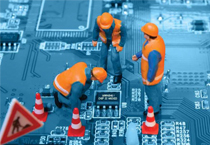IoT user organisations are moving towards a data driven strategy where deployments are utilised for multiple applications, writes Kate O’Flaherty.
Companies have historically monetised Internet ofThings (IoT) applications through efficiency improvements. This still stands, but the way businesses view their deployments is changing. User organisations are starting to look beyond investing in IoT platforms for a single deployment. Instead they are taking a wider view that investments can be used for multiple applications and therefore monetised better.

This evolving model is being driven by the huge amounts of data collected by businesses – dubbed big data – and their growing ability to analyse it. According to Ian Hughes, IoT analyst at 451 Research, companies are achieving greater efficiency gains by applying machine learning and analytics “to understand things better”.
Jon Collins, analyst at Gigaom, explains: “If you look at the architecture of IoT it’s about managing streaming data from multiple sources; putting it into a back end data store that can be accessed multi-dimensionally in real-time; and adding big data analytics alongside that.” Everything in the industrial sectors can be improved in this way, says Hughes. For example, he says: “You can use less fuel, you can break down less and you don’t send so many people out in the field to fix things. This means you are bound to save money and maximise investment in the kit.”
Data mining
As analytics systems improve, firms now have the infrastructure to perform data mining within IoT, says Theresa Bui, the head of enterprise product marketing for IoT cloud at Cisco Jasper. This gives them an enhanced ability to understand the customer and it is then possible to offer a better service, she says.
Bui explains: “People aren’t just adding devices into the field. They want a relationship with the customer and this is where the monetisation comes in. Instead of being a transaction based product sale, it’s a relationship where the vendor can sell new services and, at the same time, pull data showing how customers are using the solution.”
Bui cites the example of a connected robotic arm being used in a factory. “You have a quarter of a million robot arms used in multiple geographies. Any time the product is down is downtime for the factory, so it is valuable to be able to diagnose and predict issues; and have the ability to resolve problems remotely so you don’t need to send someone out.”
She adds: “This type of remote diagnostics is in itself a service; so the customer is buying an additional IoT based solution.”
With this in mind, the ability to use IoT data for multiple purposes is valuable to those looking to introduce extra revenue streams. One firm already using IoT in this way is car manufacturer Tesla Motors, which is able to perform remote engine diagnostics as well as mine data from its devices, says Bui.

It has started to benefit from this approach. In 2014, when Tesla’s vehicles were recalled due to a safety problem, the manufacturer was able to quickly issue an over-the-air software update. “That understanding, and being able to use data to pin point the issue, increases efficiency for Tesla and makes it a better experience for the customer. That’s a company taking it a whole step further using data,” says Bui.
Another use case that could see multiple gains from one deployment is smart cities, says Hughes, citing the example of lighting.
He says: “They aren’t just a light; they tend to be sensor nests of other things such as a camera to check parking spaces, or footfall. IoT crosses silos and industries.”
The cross-over happens in consumer led markets as well, says Hughes. For example, one platform enabling two products might be a smart light bulb and a child safety device which would cause the home lights to flash red if the child was out of range.
Hughes says: “That is a service. IoT doesn’t care what things are, so there’s monetisation in crossing those boundaries.”
With this in mind, the energy sector is an industry that will make money from the further growth of IoT. Dmitry Bagrov, the UK managing director of technology consulting firm DataArt, says increased connectivity in homes will see the area reach its full potential. “What will be a game-changer for most people will be the ability for an IoT system to monitor and alert, in real-time, problems with their heating system. In the very near future, it will be possible for your boiler to know which parts are about to fail and alert the energy company.”
So while monetising the IoT comes from operational efficiency, it can also aid safety and risk management. Steve Baker, business development director at The Technology Partnership cites the example of car insurance firms placing devices in vehicles to monitor how users drive.
IoT’s future
There is no doubt IoT’s potential is multidimensional. As firms start to realise the gains that can be had, the trend towards a multiple service model will soon become common.

In the future, this business model will be widely applied to general products, says Hughes. “Things will become a subscription product rather than a one-time buy. For example, a tyre manufacturer could charge you for how much you drive. This results in improved customer service, better products, brand loyalty and the customer is only paying for what they use. There are a lot of options, because IoT is so many things.”
This means that in the end, the monetisation comes on two levels, says Bui. The first is recurring from monthly subscriptions for a service. “Then it comes from a portfolio of services – so you can subscribe to more than one. That’s the real opportunity of IoT: it’s the enabler of recurring as well as new types of revenue.”
Bui thinks this will eventually see companies start to expand into areas outside their core offering. She cites the example of US security company Vivint. “They are starting to look outside of home security and automation and have tested services such as cloud storage. All their products are managed in the cloud and they have this infrastructure: Why wouldn’t you want to connect another device in your house for a small additional fee?”










